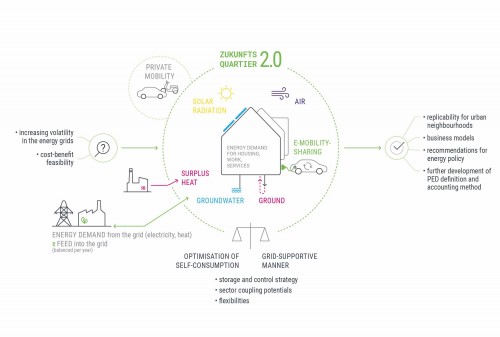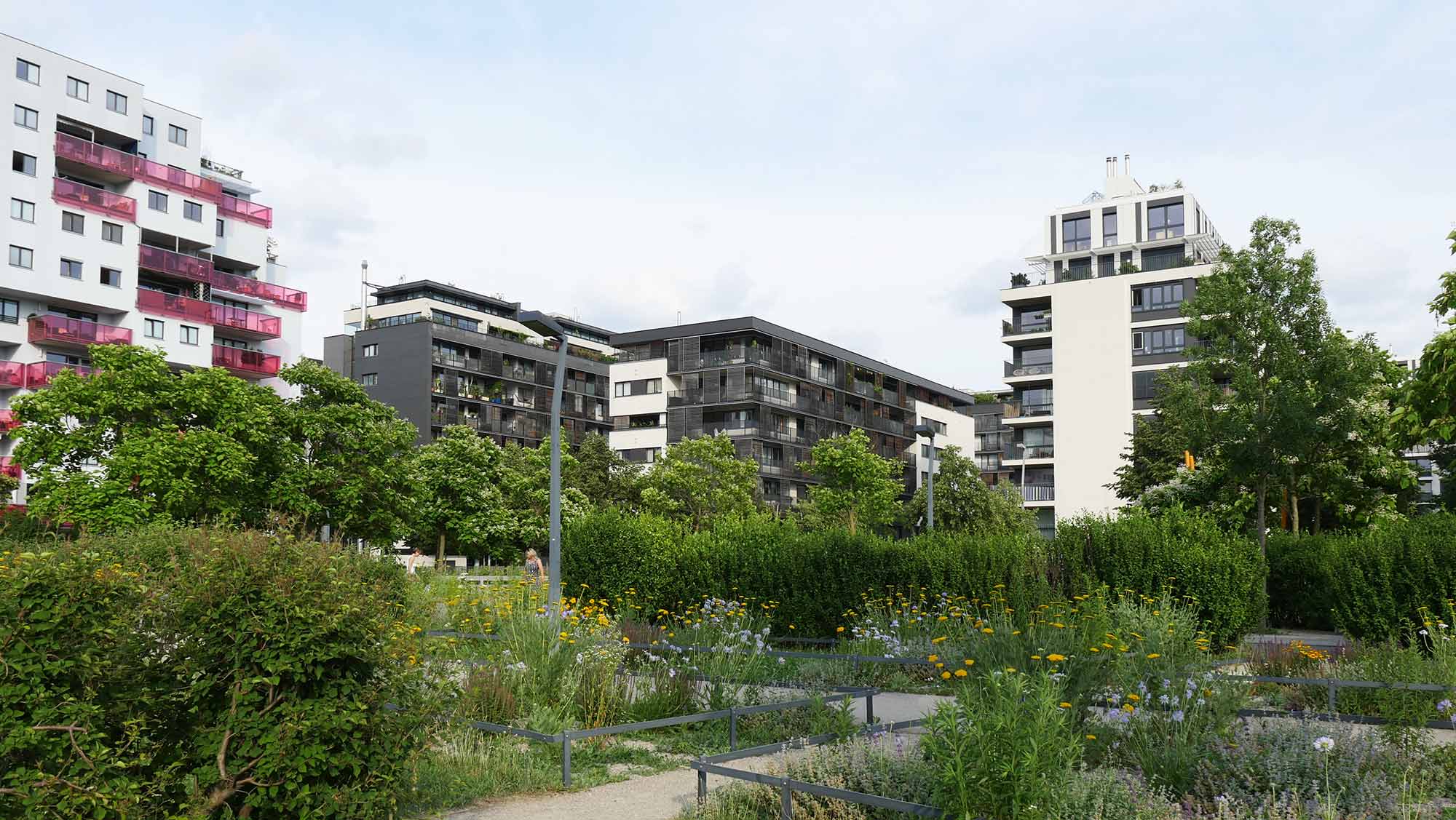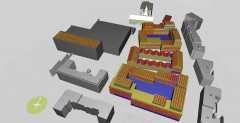Positive energy districts have the potential to become key components of a sustainable, reliable and affordable energy supply in urban areas.
Positive energy districts (PED) are areas of towns and cities that are able to meet their energy needs from renewable sources. Much of this depends on how densely packed their buildings are.1
The concept aims to put most of the energy that is generated on site to local use, making sure that peaks in supply and demand are handled correctly. In order to be able to feed surplus energy into the grid and minimise peak loads, a smart system is required to control the production, consumption and storage of renewable energy, and buildings must be highly energy-efficient.
Initial concepts for positive energy districts were developed by UIV Urban Innovation Vienna GmbH together with the University of Applied Sciences Technikum Wien, the IBR & I Institute of Building Research and Innovation in a previous exploratory study entitled “Zukunftsquartier” (“district of the future”). This in-depth look at supply concepts and modelling of different variants laid the groundwork for flagship energy neighbourhoods to be created in Vienna. The energy concepts developed combine maximum-efficiency buildings with a substantial volume of energy generated locally by large-scale PV plants and ground source heat pump systems or thermal networks, combined with demand-side management (DSM) and thermal storage systems (thermal building activation systems, underground storage systems).
The follow-up project, “Zukunftsquartier 2.0” 2, is conducting research into integrating districts that generate a lot of energy locally and feed into the grid infrastructure (power and district heating) in a grid-supportive manner. The aim is to create a “win-win” situation for energy suppliers and grid operators, investors and developers and, ultimately, users as well. Both sector coupling and thermal networks offer significant potential. Urban districts harbour potential for greater flexibility that has rarely been exploited to date in such a wide range of small-scale, decentralised units. “Zukunftsquartier 2.0” is a highly practical project that is focused on implementation. As such, it is demonstrating how smart load shifting and storage management that benefits the grid can work in innovative positive energy districts in dense built-up urban areas. Initial results show that, if the concept is to be implemented economically and sustainably, the positive energy approach has to be factored into the planning process from an early stage. A moderate building density in the urban district is needed and the district’s buildings should be mixed-use.
How urban districts and grids interact
Technical, economic, legal and social issues are being analysed as part of the project. A method for optimum system design including storage technologies for newly planned urban districts is being devised, and a regulation strategy is being developed to enable the positive energy urban area to interact with the overall system. The intention is for daily, weekly and seasonal storage systems in the district to be able to respond flexibly and cross-sectorally to demands from the grids and prevent or at least soften demand and supply peaks. A key focus when planning the utilities ma-nagement concept lies on issues of social acceptance and user-friendly load shifting measures that are also feasible in practice. Cost optimisation measures are to be analysed over the entire life cycle and suitable business and operator models proposed in order to enable cost-effective implementation.

Helping to plan a neighbourhood in Vienna
The project team is currently supporting the planning of an area of Floridsdorf (Pilzgasse), Vienna, which has been designed as a positive energy district. If innovative energy concepts are to be implemented cost-effectively, specific requirements have to be embedded right from the first stage of the planning process. Energy-related specifications regarding the structural shells of buildings and their floor plans were therefore included in the architectural competition. This ensures that PV modules will be integrated on a large scale and in an architecturally attractive way while also allowing cost optimization during implementation. Participants and stakeholders in other potential positive energy neighbourhoods (e.g. the Ottakring site and parts of Seestadt Aspern) are also to be involved as part of the project. Close coordination between researchers, property developers and planners will produce solutions that can be replicated elsewhere. The results will be made available in the form of instructions and tools for conducting and supporting future planning processes of urban district developments.
greenenergylab.at/projects/zukunftsquartier-2-0/
1 https://nachhaltigwirtschaften.at/resources/sdz_pdf/schriftenreihe-2020-11-zukunftsquartier.pdf
2 Project partners: UIV Urban Innovation Vienna GmbH (project management), University of Applied Sciences Technikum Wien, IBR & I Institute of Building Research & Innovation ZT GmbH, SÜBA AG,
Böhm Stadtbaumeister und Gebäudetechnik GmbH, hacon GmbH
The project is being funded as part of the City of Tomorrow research programme and is an associated project of the Green Energy Lab.

